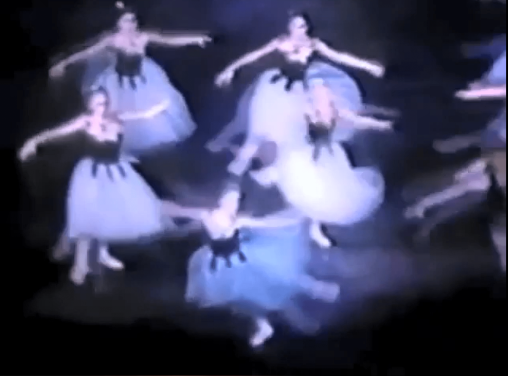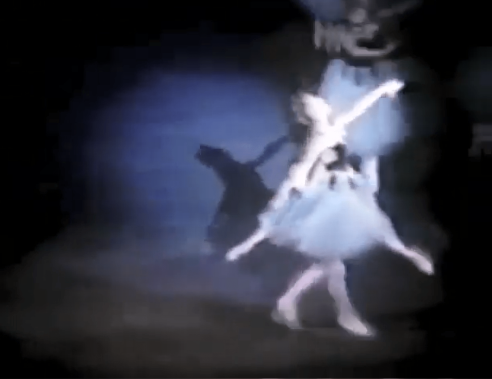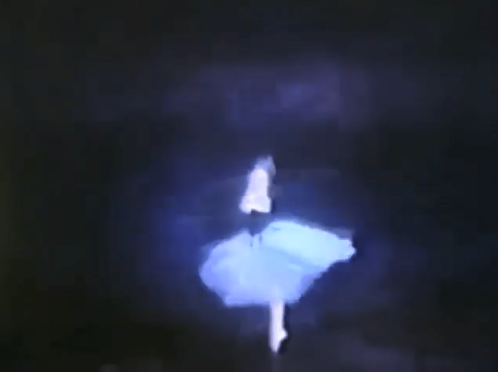…How she dances…
The featured dancer in the above clip is Violette Verdy, in excerpts from the “Emeralds” section of Balanchine’s Jewels (1967). It’s posted on John Clifford’s YouTube channel, a must-subscribe for dance lovers, especially for Balanchine fans. Clifford was a leading dancer with the New York City Ballet, and he’s recently published his memoirs about his career, Balanchine’s Apprentice. The videos on his channel are an invaluable collection of some of NYCB’s greatest dancers, filmed in their prime, as well as a magnificent survey of Balanchine’s choreography, performed by the dancers he trained.

The ballet Jewels has been called the first evening-length abstract ballet, its three acts linked by the motif of jewels—the glow of emeralds, the sparkle of rubies, the radiance of diamonds. Per Balanchine’s Complete Stories of the Great Ballets, Balanchine’s inspiration stemmed from a visit to the jeweler Claude Appels’s fabled collection; “I like[d] the color of gems, the beauty of stones,” Balanchine says. With its glittering Karinska costumes, and its intricate, multifaceted choreography—Laura Jacobs notes how Balanchine’s “inventive use” of such positions as effacé, croisé, and ecarté “show[s] us the jeweler’s cut and bevel inherent in classical technique”—Jewels can be viewed an ecstatic meditation on the brilliance and splendor of gemstones, the aim of which, says Jacobs, is to “sho[w] off the [balletic] art’s most precious gems: its ballerinas.”
One of this ballet’s most precious of its original ballerinas was surely Violette Verdy, on whom Balanchine choreographed one of the leading roles in “Emeralds,” Jewels’ lead-off ballet. “Emeralds” is generally considered to be the choreographer’s tribute to France. Jacobs notes how the ballet’s three sections may signify the three cities where Balanchine chiefly worked: “Diamonds,” danced to Tchaikovsky, representing St. Petersburg, where Balanchine was a student at the Maryinsky; “Rubies,” to Stravinsky, embodying New York, home to his ballet company; while “Emeralds,” to the music of Fauré, is Paris, the birthplace of Western classical dance. Balanchine himself confirmed the last allusion, noting that if “Emeralds” “can be said to represent anything at all,” then it’s “an evocation of France, the France of elegance, comfort, dress, perfume.”


How apt, then, for the ballet’s France/Paris section to be made on New York City Ballet’s French-born and -trained ballerina (one video commenter writes, “The French perfume of her dancing comes through”). As her Wikipedia profile notes, “[o]f all [her NYCB] roles, Verdy is perhaps most identified with Emeralds…embod[ying] the Romantic spirit of Fauré’s music.” And Romanticism, in balletic/aesthetic terms, is at the core of “Emeralds.” If the swift, jagged pulse of “Rubies” is 20th-century jazzy modern, and the calm classicism of “Diamonds” is Petipa grandeur, then the lushness of “Emeralds” is full-blown 19th-century Romantic ballet, so closely associated with Paris. With its long tulle skirts, its aura of mystery, its subdued emotion and sensuality, and its swirling, darting, yet limpid choreography, the ballet is the emanation of the Romantic era—of fleet, elusive women in Degas tutus pursued by haunted, black-doubleted men, in quest of an idealized, intangible beauty—always sought but never captured.

The original “Emeralds” cast included Verdy and her partner, Conrad Ludlow, and with Mimi Paul and Francisco Moncion as the other main couple. But the above short film (just over 12 minutes) focuses on Verdy, featuring, says Clifford, “Ms. Verdy’s solo, and opening and closing of the ballet.” Clifford doesn’t indicate when this performance was filmed or who the other dancers are (I’m assuming Ludlow is partnering her here…?). Nor do we know its provenance: As precious a document as it is, the film unfortunately looks as if it was left out in the rain—its images blurry and its colors so bleached and faded that everything looks blue. (I’m guessing the original film was copied onto videotape, which has badly deteriorated.) Clifford writes the film was shot silent, and the music added later; although during Verdy’s solo (starting @ the 5:25 mark), no music is heard at all, only a scratchy white noise on the soundtrack. Her dancing, however, is so compelling, you honestly don’t hear the static as she dances.


And how she dances. Verdy moves to music with not just her body but her soul. “My god,” I found myself thinking, “she’s so musical!”—only to realize this was during the video’s silent portion. So potent is her musicality, so rooted in her body, that you sense it, feel it, beyond hearing. Even in the flatness of film, you perceive Verdy in three dimensions, torso, head, arms, hips, legs moving in a twining, turning, rounding opposition; it’s like those drawings of dancer’s bodies through which arrows and lines swirl and circle to give a sense (in two dimensions) of how the torso moves in and through space, its limbs in relation to a stable axis. Verdy herself dances in such fashion; you sense a calmness at her core, from which springs something deep and vital. In contrast, the dancing of the other ballerina in the final section (Mimi Paul?) looks nervous and tossed. Yet Verdy is never in stasis; because her body is so centered, she can turn, skim, lean, leap, pose off balance, but never seem rushed or agitated. It paradoxically gives her greater freedom to move in any direction, while always, as in nature, to be moving.


Verdy’s dancing also plays off that sense of nature in “Emeralds,” whose choreography creates onstage what Jacobs calls “a fairy-tale forest.” Its dance sequences twist, eddy, and flow, as if tracing pathways through flower beds; a line of women will turn, break apart, then rejoin and seamlessly continue its dance, in a constant ebb-and-flow as of currents of air or water. I recall once reading an interpretation of Jewels as a portrait of one city, New York—”Rubies” being Times Square, “Diamonds” the city’s night skyline, and “Emeralds” as Central Park. With its green costumes, and only a green cyclorama as background, “Emeralds” leaves it to us to decide where it’s taking place; though my own sense is that the Romantic ballet depicted here is not in the moonlit forest of, say, Giselle or La Sylphide, but in a brightly lit park or garden—perhaps on a broad span of sunlit grass, where couples stroll in formalized courting rituals, or in a secluded glade, bounded by trees, where lovers chase, hide, and embrace in solitude.

It’s in this Romantic garden that Verdy dances in the style of a Romantic ballerina, albeit one with the speed and technique of the modern era. Note her phrasing, so liquid and expressive, her arms seem to be weaving flowers into a wreath; it gives her dancing that quality, at once private and artless, of a fabled Romantic sprite, a wood nymph glimpsed at play (what would Verdy have been like as the Sylphide?). In the pas de deux she spins in and out of her partner’s embrace as one too intangible to be held or contained; in a lift she rises weightlessly, as if swept aloft by a breeze; or she will turn, pause, pose, effortlessly, in piqué arabesque, about to spring from gravity’s grasp. It recalled to me those descriptions of 19th-century ballerinas who were said to move so lightly so as not to touch the floor—your thought is that’s an imaginative projection on the smitten writer’s part; but yet here it is, that very image, in Verdy’s flesh embodied.


I confess, I had a tough time writing this post. There is, in Verdy’s dancing, an idealized beauty, one of such jewel-like brilliance, yet of such evanescence, that I can’t capture it in leaden words. Her dancing is so natural, its technique ‘vanishes, as it were, as you watch; it looks as simple, as instinctive, as breathing. It’s why you ‘see’ the music in her body even when you don’t hear it. Her dance impulse must spring from nature itself, from an internal, eternal sway of motion in relation to air, water, fire, earth. How apt, then, is her stage name—’Violette Verdy’—evoking flowers and greening springtide, while its floating, alliterative rhythm, as you speak it, suggests a being who leaps into the air, to be carried off by the wind.

I never got to see Violette Verdy dance on stage. We have now only her fleeting, shadowy images, on old, crumbling films, that, in their poor quality, seem to vanish, like dancing itself, before our eyes. Yet these films do manage to capture, however faintly, her greatness as a dancer—of that fusion of motion, rhythm, expression, and sheer art that only the trained, disciplined, musical body can convey. How to describe it? I’m reminded of that bit from The Red Shoes (that Ultimate ballet film…), when Lermontov sneers at that trite phrase, “the poetry of motion,” to define dance. Yet how else to describe how Verdy danced? Perhaps an actual poet, William Butler Yeats, may have best captured it (however unknowingly): “O body swayed to music, O brightening glance,/How can we know the dancer from the dance?” Those lines, now so overquoted, may themselves have become trite. But watching Violette Verdy dance just like that—as a direct emanation of her very being, as woman, dancer, and artist, which can only be seen, and felt, as she dances—their meaning once again lives, with the freshness of violets and the greenness of Nature, before our pursuing, haunted eyes.
